TAKEAWAY: It’s no secret that many magazines, like newspapers,are not doing well attracting and keeping readers. It is particularly difficult for the newsmagazines, and, especially Newsweek. I talk to two well respected colleagues: Roger Black and Bob Newman about the state of magazines in the US today.
The 24-hour news cycle conspires against newsmagazines, too
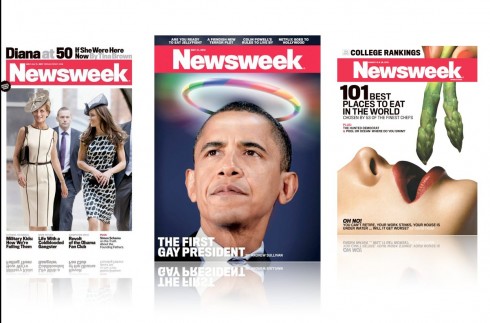
Three Newsweek covers that have created controversy, including the current one (right)
It’s all about magazines today. A New York Times piece asks the question: how far will magazines fall? And New York Magazine seriously considers responsive design.
Although The New York Times’ piece addresses newsmagazines generally, it deals almost entirely with Newsweek and how the iconic well known magazine has not been able to right itself even under the watchful eye of its star editor, Tina Brown, who attempted to marry her website, The Daily Beast, with the struggling Newsweek.
Success has eluded Tina Brown, even though it has been obvious that Newsweek, under her leadership, has taken bold steps, especially on the cover, where we have seen some rather wild treatments such as a photo of Barack Obama with the headline: First Gay President. But, as the piece suggests, perhaps Tina’s medicine for Newsweek has kept the mag from falling faster. While circulation is down about 9% for Newsweek, some of its competitors are experiencing a worse fate: People is down 18.6% and The New Yorker 17.4%.
I have asked my friend and colleague, Roger Black, , one of the world’s most prolific media designers (he redesigned Newsweek in one of its many visual reincarnations) about his views on Newsweek :
“The definition of a newsmagazine has morphed since Time was started 90 years ago. Originally it was a news round-up for people who didn’t get newspapers. Time had a rewrite desk with lots of talented Yalies turning out clever prose. As newspapers and then television did more comprehensive coverage, the newsmagazines felt they had to push toward analysis and features. “
Another well respected colleague I have talked to is Bob Newman, until recently creative director for Reader’s Digest. Bob thinks that Newsweek, in spite of some good content and design, has had trouble getting a following:
Newsweek’s big problem has been finding their audience and then digging deep into it. I can tell you who The New Yorker reader is, but I can’t say that about Newsweek. I’ve always liked Newsweek and I like a lot of what’s going on there, especially Dirk Barnett’s design and visuals. But they seem hung up between being that old-school newsmagazine of record and being something more new and modern. I think they need to go much more MSNBC to Time’s CNN, if that makes sense. It’s not enough to attract attention for what’s on your cover. That gets you a lot of covers passed around the internet and some commentary on the cable news shows. But it doesn’t translate into new readers and revenue. For that you’ve got to have compelling content. It’s funny, because I feel like The Daily Beast has a much crisper identity than Newsweek does, and as a source of information and analysis, I much prefer the Beast website.
Is the newsmagazine genre an endangered species?
My question, for which I do not have an answer: Are we seeing less interest in newsmagazines, period? Is the newsmagazine genre not something that readers in the second decade of the 21st century find compelling or useful?
Perhaps we as media consumers have gotten spoiled, and definitely have become more impatient, and we know that we will get the news, the rehash and the analysis all within a 24-hour-news cycle. So what is the weekly newsmagazine to tell us that we may not know, whether it is the Olympics, or the addition of a new name to the Republican presidential ticket?
The 24-hour-news cycle is NOT just about news: it is about taking that Tweet when news breaks and extending it and updating it, all as quickly as possible. Waiting is not a virtue of today’s media consumer.
In fact, in The New York Times story, its author, David Carr, refers to the element of time as one of the obstacles facing newsmagazines today:
Making a weekly newsmagazine has always been a tough racket. It takes a big staff working on punishing deadlines to aggregate the flurry of news, put some learned topspin on it and package it for readers. But that job now belongs to the Web and takes place in real time, not a week later.
A reader’s view
For example, I am an avid newsmagazine reader, with subscriptions to both Newsweek and TIME. I confess that I get through those issues faster these days, turning the pages quickly as I remind myself that I have already seen and read enough of about 70% of the content of a specific issue. While I am not cancelling my subscriptions—-not yet—-I am aware that the benefit I get as a consumer has become less and less.
One exception for me: The Economist. This is my ultimate lean back reading experience each week. Perhaps it is because The Economist editors seem to know that I know about almost each of the items in their weekly issue of the magazine, but, starting with the headline, they put a new spin on it, and the story delivers.
Yet,Roger Black feels that it is news that may be missing from the current Newsweek:
Before Tina, Newsweek decided it had to drop its reporters and news stories altogether, since the web was delivering news updates every second. Jon Meacham cobbled up a lot of quick features along the lines of “What Would FDR Do?”
That failed, and the Grahams sold the magazine to the Hi FI baron for a dollar, who brought in Tina (and Barry Diller) They dumped the history in favor of personality profiles and trend pieces with a bit of controversy. It’s an interesting mix, but it ain’t news. And, it turns out there is of a glut of celebrity gossip and opinion about current events on the web. It’s the blogosphere.
Bob Newman adds:
My feeling is that newsmagazines are never going to be moneymakers. We’re already seeing the future of the newsweekly: it’s a subsidized, non-profit making (or money-losing) operation, like Bloomberg Businessweek and to a lesser extent, The New Yorker (I think The New Yorker probably makes a little money, but it helps that it has Conde Nast supporting it). It’s no coincidence that many people think this is the future of daily newspapers as well, and we may soon be approaching the time where the publishing schedule of newsweeklies (who for the most part don’t come out 52 times a year) and newspapers become more or less the same. Ironically, in New York, you’re seeing some newsmagazines, notably The Week and Bloomberg Businessweek, being delivered along with the daily newspaper, avoiding the mail entirely.
Who is doing it right?
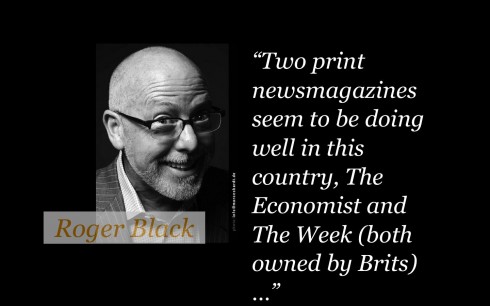
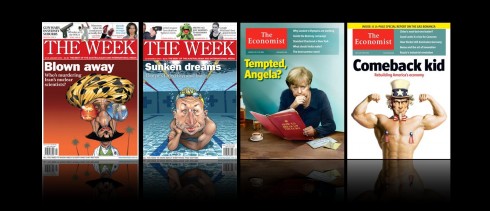
The Economist, The Week, two British imports doing well in the US
I asked Roger Black whom he thinks is doing it right:
Two print newsmagazines seem to be doing pretty well in this country: The Economist and The Week. (Both owned by Brits.) The Economist has lots of reporters and you get a lot of information you might not picked up elsewhere—in a short, lively form. I can’t wait till it comes out on Friday. The Week is doing exactly what Time started out doing. Summarizing news glommed from other outlets, and a adding a bit of spin and entertainment value. People love it.
By giving up original and aggregated news content, both Time and Newsweek may have missed the boat.
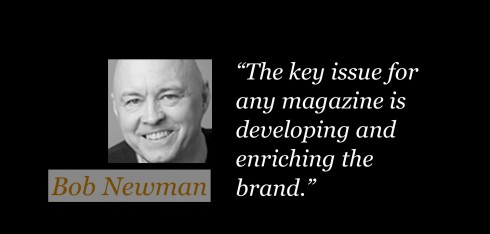
For Bob Newman, it is The New Yorker doing it right:
I think at this point the key issue for any magazine is developing and enrichening the brand. It’s not about formats and platforms; it’s about content and connecting with an audience. The New Yorker has been so smart and effective with their website, blogs, tablet apps, and now iPhone app/feed. And they’re constantly renewing the brand and intensifying their identity with their readers. The New Yorker drives and adds to the conversation; it’s smart, provocative, enlightening, entertaining, and visually stimulating. It still feels vital and essential to me.
Magazines and the iPad:
I still think the tablet edition of these newsmagazines could do more to carry the brand to a new generation of consumers, but ONLY if those tablet editions explore the full potential of the platform. For the newsmagazines that I know, this is not happening yet.
it should be a marriage made in heaven. And, indeed, it seems to be heavenly for a number of examples, including Sports Illustrated, Reader’s Digest, The Iconist, National Geographic, the new Vogue, and, of course, Wired, among others. When it is well done, it is the tablet at its best.
I am hoping that the newsmagazines will continue to work hard to make their tablet editions more visual, tablet driven and rich in pop up moments and multi media. I see tremendous possibilities for newsmagazines to improve on how photography is presented (let the old LIFE inspire you), but I also envision exploring the cult of personality (their well read and popular columnists appearing on video, chatting their messages to the readers, in addition to the written word).
Parting shot
As we will most likely continue to discuss the fast shifting dynamics of newspapers and magazines as they struggle with their printed editions, perhaps this anecdote from Bob Newman in our interview for this blog of today, says it all:
A couple weeks ago we had a meeting at Reader’s Digest with our summer interns. They’re a bright bunch of young people, smart, funny, interested in all kinds of media, and they all want to work for print magazines when they leave school. Someone asked them about where they get their news, and they all said “on my phone.” Twitter was their #1 source of updated news. That’s what the newsmagazines are struggling against.
Previous blog posts about Newsweek
We take a look at Newsweek’s new iPad app
https://garciamedia.com/blog/articles/we_take_a_look_at_newsweeks_new_ipad_app/
The new Newsweek: seductive, serious—and this week—creepy
https://garciamedia.com/blog/articles/the_new_newsweek_seductive_serious—-and_this_week—creepy/
The new Newsweek in temp with what a modern printed newsmagazine should be
https://garciamedia.com/blog/articles/the_new_newsweek_in_tempo_with_what_a_modern_printed_newsmagazine_should_be/
New York Magazine and Responsive Design
Little by little, responsive design seems to be making inroads as more publishers are attracted by the functionality and ease that it affords. I have been a fan of responsive design from the first time I heard one of its pioneer advocates, Ethan Marcotte, present it when we both appeared in the same program in 2011. So I am always on the lookout for any references to responsive design, such as this recent one about New York Magazine considering going for responsive design.
Responsive design is when the layout is formatted in such a way that one look can be carried across platforms: — desktop, tablet, phone. The Boston Globe has been one of the first to introduce responsive design.
Why would New York Magazine consider responsive design?
Practicality and savings may be two good reasons. New York Magazine launched a fashion site this week called The Cut and it may be the pilot for how responsive design might be used with the magazine.
Our previous blog posts with references to responsive design:
https://garciamedia.com/blog/articles/newspapers_become_hot_properties_again/
https://garciamedia.com/blog/articles/austrias_wirtschaftsblatt_mobilista_workshop_a_step_closer_to_seamless_inte/
https://garciamedia.com/blog/articles/creating_the_next_generation_website_mobilista_2_workshop/
SPD: Speaker Series Begins with “News You Can Use”
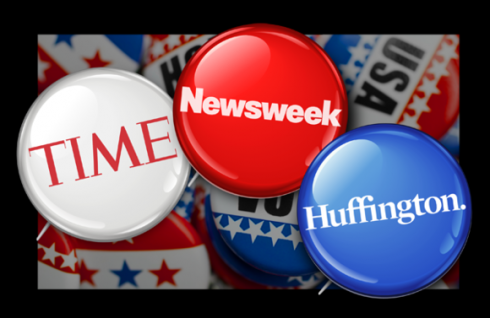
(Joe Zeff Design Illustration, courtesy of SPD)
Tickets are now available for the Society of Publication Designers’ first Speaker Series event of the fall, “News You Can Use,” scheduled Sept. 10.
For more information:
http://www.spd.org/2012/08/speaker-series-begins-with-new.php
SND Scandinavia Space 2012 conference
Still time to get a spot to attend the SNDS conference in Copenhagen, Sept. 27-29;
For more information:
SNDS workshop ever. Read all about SPACE 2012 here:
The iPad Design Lab: Storytelling in the Age of the Tablet
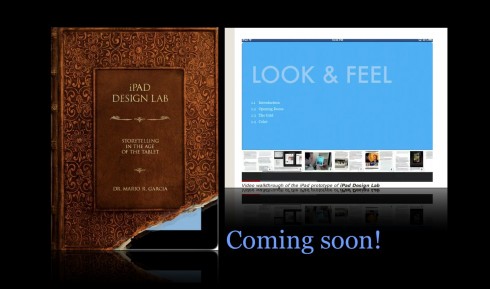
Video walkthrough of the iPad prototype of iPad Design Lab

Mario Garcia’s upcoming speaking engagements:

WAN-IFRA World Editors Forum, Kiev, Ukraine, Sept. 2-5
http://www.wan-ifra.org/events/64th-world-newspaper-congress-19th-world-editors-forum
Cumbre Mundial de Diseño en Prensa 2012: Mexico City; September 24-26
http://www.cmdprensa.com/mx2012/
SND (Society of News Design) Cleveland; Oct. 11-13
http://cle.snd.org/